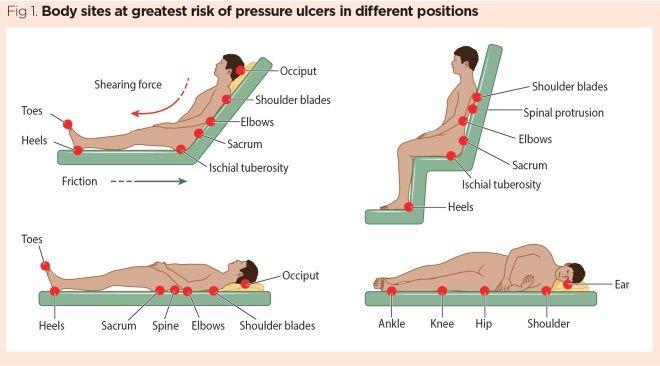Preventing Pressure Injuries
A pressure injury (also referred to as a bed sore or pressure ulcer) is an injury to the skin caused by unrelieved pressure and can occur when you are unable to move due to surgery, illness or injury.
Pressure injuries can happen quite quickly, from lying or sitting in the same position for too long. They can be painful and can take a long time to heal.
The diagram below shows the vulnerable areas of the body when lying and sitting.

Signs of a pressure injury:
- Red / purple / blue skin
- Blistering
- Swelling
- Dry patches
- Warm or cool areas
- Shiny areas on skin
- Pain / tenderness
Factors that may increase the risk of developing a pressure injury include;
- Poor nutritional state
- Poor health or weakness
- Weight loss or weight gain
- Urinary and faecal incontinence
- Excess moisture or dryness of skin
- Past history of pressure injury
- Wearing ill-fitting shoes or clothes with tight elastic
- Lack of sensory perception e.g. diabetes or multiple sclerosis
Reducing the risk of a pressure injury:
- Patients, family, care givers and staff can all help to reduce the risk of pressure injury
- On admission the nurses will assess your level of risk of developing a pressure injury
- If you are unable to move yourself, staff will help you to change your position frequently
- You can involve carers by asking them to remind you to change your position regularly
- It is important to let the staff know if your clothing or bedding feel damp so they can change it. Ask for help if you have a weak bladder or bowels.
- Let staff know if you have any of the signs of pressure injury.
- Drink plenty of fluids (unless you are on a fluid restriction diet) you may be offered nutritional supplements if you are under weight or are eating poorly.
- Keep your skin clean and dry. The staff may advise the use of a “skin-friendly” moisturiser.
- Be aware of the risk of pressure injury under anti embolism stockings, drains and around tubes.
- Specialised pressure relieving equipment such as mattresses can be used to reduce the risk of pressure injuries in hospital.
Managing a pressure injury
If you have a pressure injury:
- Staff will discuss how best to manage your pressure injury with you and your family and formulate a care plan
- Use the prescribed equipment recommended at all times
- Move frequently (where possible) to relieve pressure
- Inspect the skin every day
DISCLAIMER This fact sheet provides general information only. For specific advice about your baby or your healthcare needs, you should seek advice from your health professional. Burnside Hospital does not accept any responsibility for loss or damage arising from your reliance on this fact sheet instead of seeing a health professional. If you require urgent medical attention, please contact your nearest emergency department.


